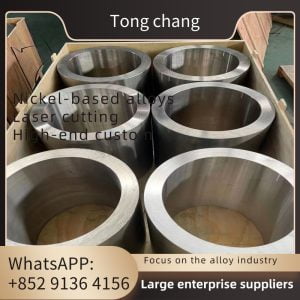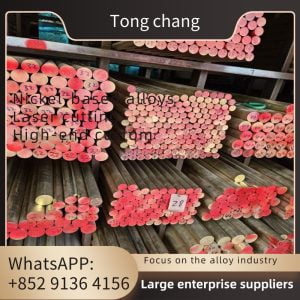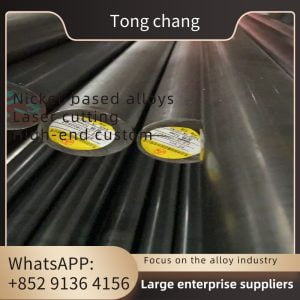| Standard: | ASTM B163 | Material: | Incoloy 825 (NO8825) DIN 2.4858 |
|---|---|---|---|
| NDT: | ECT, HT | Application: | Boiler, Heat Exchanger |
| High Light: | Heat Exchanger Nickel Alloy Bar, Incoloy 825 Nickel Alloy, Seamless Alloy Steel Pipe HT | ||
ASTM B163 Incoloy 825 (NO8825) DIN 2.4858 SEAMLESS TUBE FOR HEAT EXCHANGER APPLICATION
Designated as UNS N08825 or DIN W.Nr. 2.4858, Incoloy 825 (also known as “Alloy 825”) is an iron-nickel-chromium alloy with additions of molybdenum, cooper and titanium. The molybdenum addition improves its resistance to pitting corrosion in aqueous corrosion application while copper content bestows resistance to sulfuric acid. Titanium is added for stabilization. The Alloy 825 has excellent resistance to both reducing and oxidizing acids, to stress-corrosion cracking, and to localized attack such as pitting and crevice corrosion. It is especially resistant to sulfuric and phosphoric acids. Incoloy 825 alloy is mainly used for chemical processing, petrochemical piping, pollution-control equipment, oil and gas well piping, nuclear fuel reprocessing, acid production, and pickling equipment.
Corrosion Resistance
The outstanding property of Incoloy 825 is its corrosion resistance. In reducing & oxidising conditions, Incoloy 825 resists general corrosion, pitting & crevice corrosion, intergranular corrosion and stress corrosion cracking. It is particularly useful in sulphuric & phosphoric acids, sulphur containing flue gases, sour gas and oil wells and sea water.
Fabrication
Incoloy 825 can be readily hot or cold worked. Hot working should be in the range 870 – 1180°C, finishing at 870 – 980°C. For maximum corrosion resistance hot worked parts should be stabilise annealed before use. The alloy is easier to cold form than stainless steels.
Heat Treatment
Incoloy 825 is stabilise annealed at 940°C. The softest structure is obtained at 980°C. Sections heavier than sheet, strip and wire should be quenched to avoid sensitisation.
Chemical Composition of Incoloy Alloy 825
Chemical composition of Incoloy Alloy 825 (ASTM B163 – Heat exchanger tube)
| Element | % | Element | % |
| Nickel | 38.0 – 46.0 | Carbon | 0.05 max |
| Chromium | 19.5 – 23.5 | Manganese | 1.0 max |
| Molybdenum | 2.5 – 3.5 | Sulfur | 0.03 max |
| Copper | 1.5 – 3.0 | Silicon | 0.5 max |
| Titanium | 0.6 – 1.2 | Aluminium | 0.2 max |
| Iron | 22.0 min (~33%) |
Tensile Properties of Incoloy Alloy 825
Typical room temperature tensile properties (not for design. Consult the relevant material or product specification for design values)
| Form | Condition | 0.2% Proof Stress MPa | Tensile Strength MPa | Elong % |
| Tube | Annealed | 440 | 770 | 35 |
| Tube | Cold drawn | 880 | 1000 | 15 |
| Bar | Annealed | 325 | 690 | 45 |
| Plate | Annealed | 340 | 660 | 45 |
| Sheet | Annealed | 420 | 760 | 39 |
ASTM Product Specifications
ASTM specifications for Incoloy Alloy 825.
| Specification | Title |
| B163 | Seamless Nickel and Nickel Alloy Condenser and Heat-Exchanger Tubes |
| B423 | Nickel-Iron-Chromium-Molybdenum-Copper Alloy (UNS N08825 and N08221)* and Tube |
| B424 | Ni-Fe-Cr-Mo-Cu Alloy (UNS N08825 and UNS N08221)* Plate, Sheet, and Strip |
| B425 | Ni-Fe-Cr-Mo-Cu Alloy (UNS N08825) |
| B704 | Welded UNS N06625 and UNS N08825 Alloy Tubes |
| B705 | Nickel-Alloy (UNS N06625 and N08825) Welded Pipe |
| B751 | General Requirements for Nickel and Nickel Alloy Welded Tube |
Other international grades that are equivalent to Incoloy Alloy 825.
| Country | Body | Designation |
| USA | UNS | N08825 |
| France | AFNOR | NC 21 FeDU |
| GB | BS | NA 16 |
| Germany | DIN | NiCr21Mo |
| Germany | Werkstoff | Nr 2.4858 |
Applications of Incoloy 825
1. Sulphuric acid piping and vessels
2. Phosphoric acid evaporators
3. Pickling tank heaters, pickling tanks and equipment
4. Chemical process equipment
5. Propellor shafts
6. Tank trucks
7. Calorifiers
8. Electrostatic precipitator electrodes
9. Hot vessels for food, water and seawater,
10. Ammonium sulphate vessels
11. Expansion bellows
12. Marine exhaust systems
12. Power station ash hoppers







